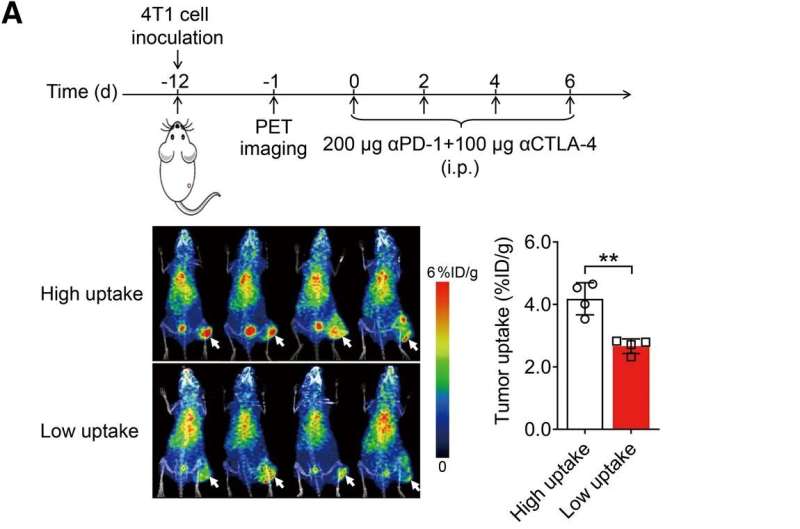This article has been reviewed according to Science X's editorial process and policies. Editors have highlighted the following attributes while ensuring the content's credibility:
fact-checked
peer-reviewed publication
proofread
Newly identified PET biomarker predicts success of immune checkpoint blockade therapy

The protein galectin-1 (Gal-1) has been identified as a new PET imaging biomarker for immune checkpoint blockade (ICB) therapy, allowing physicians to predict the tumor responses before beginning treatment.
Information garnered from Gal-1 PET imaging could also be used to facilitate patient stratification and optimize immunotherapy, enabling targeted interventions and improving patient outcomes. This research was published in the May issue of The Journal of Nuclear Medicine.
Immunotherapies, such as ICB, have produced promising clinical outcomes in melanoma, non–small cell lung cancer, and several other types of tumors. However, only a subgroup of patients experiences positive outcomes with objective response rates spanning between five and 60%.
"Developing reliable approaches for assessing responses and selecting eligible patients for immunotherapy remains challenging," said Zhaofei Liu, Ph.D., Boya Distinguished Professor at Peking University in Beijing, China.
"Current clinical criteria for monitoring solid tumor responses to immunotherapy are based on CT and MRI scans, but these methods result in a considerable delay between treatment commencement and response evaluation. Molecular imaging techniques, especially PET, have emerged as robust tools for predicting immunotherapy effectiveness through the real-time, quantitative, and noninvasive assessment of biomarkers in vivo."
In the study, a mouse model was utilized to identify new imaging biomarkers for tumor responses to ICB therapy. Through a proteomic analysis (separation, identification, and quantification of proteins in a tumor), researchers found that tumors exhibiting low Gal-1 expression responded positively to ICB therapy.
Next, Gal-1 was labeled with 124I and the radiotracer (124I-α-Gal-1) and small animal PET imaging and biodistribution studies were conducted to assess the specificity of the radiotracer. PET imaging with 124I-αGal-1 showed the immunosuppressive status of the tumor microenvironment, thus enabling the prediction of ICB resistance in advance of treatment.
For tumors that were not predicted to respond well to ICB therapy, researchers developed a rescue strategy that utilized a Gal-1 inhibitor that significantly improved the chance for success.
"Gal-1 PET opens avenues for the early prediction of ICB efficacy before treatment initiation and facilitates the precision design of combinational regimes," noted Liu. "This sensitive approach has the potential to achieve individualized precision treatment for patients in the future."
More information: Ning Liu et al, Noninvasively Deciphering the Immunosuppressive Tumor Microenvironment Using Galectin-1 PET to Inform Immunotherapy Responses, Journal of Nuclear Medicine (2024). DOI: 10.2967/jnumed.123.266888





















